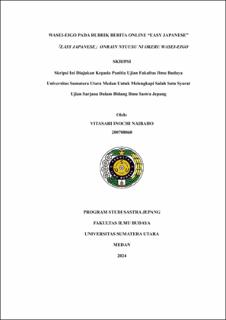| dc.contributor.advisor | Sihombing, Amin | |
| dc.contributor.advisor | Arfianty, Rani | |
| dc.contributor.author | Naibaho, Vitasari Inochi | |
| dc.date.accessioned | 2024-11-08T08:22:33Z | |
| dc.date.available | 2024-11-08T08:22:33Z | |
| dc.date.issued | 2024 | |
| dc.identifier.uri | https://repositori.usu.ac.id/handle/123456789/98674 | |
| dc.description.abstract | This study discusses wasei-eigo found in Easy Japanese online news. Wasei-eigo refers to words or phrases created in Japan using elements of English but with meanings that are different or unknown to native English speakers. The study aims to classify wasei-eigo based on the theories of Shibasaki, Tamaoka, and Takatori found in digital media, and to explore their usage in online news. The research results indicate there are 27 forms of wasei-eigo categorized into six categories: seven in imizurekata, one in tanshukukata, one in junwaseikata, 16 in eigohyogenfuzaikata, one combining tanshukukata and eigohyogenfuzaikata, and one combining junwaseikata and eigohyogenfuzaikata. All identified wasei-eigo undergo semantic changes from their original English counterparts, with some words uncommon in English but widely used in Japanese. | en_US |
| dc.language.iso | id | en_US |
| dc.publisher | Universitas Sumatera Utara | en_US |
| dc.subject | wasei-eigo | en_US |
| dc.subject | category | en_US |
| dc.subject | easy Japanese | en_US |
| dc.subject | online news | en_US |
| dc.subject | meaning | en_US |
| dc.title | Wasei-Eigo pada Rubrik Berita Online “Easy Japanese” 「Easy Japanese」Onrain Nyuusu Ni Okeru Wasei-Eigo | en_US |
| dc.title.alternative | Wasei-Eigo in The Easy Japanese Online News Column | en_US |
| dc.type | Thesis | en_US |
| dc.identifier.nim | NIM200708068 | |
| dc.identifier.nidn | NIDN0003046007 | |
| dc.identifier.nidn | NIDN0010117602 | |
| dc.identifier.kodeprodi | KODEPRODI79204#Sastra Jepang | |
| dc.description.pages | 103 Pages | en_US |
| dc.description.type | Skripsi Sarjana | en_US |
| dc.subject.sdgs | SDGs 4. Quality Education | en_US |


